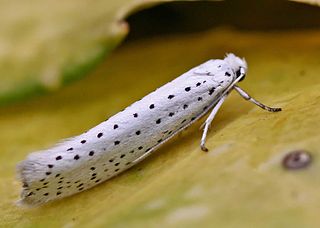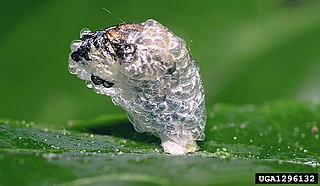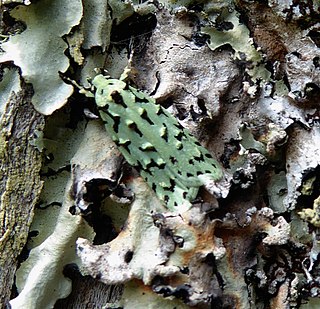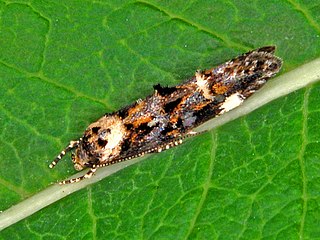
The luna moth, also called the American moon moth, is a Nearctic moth in the family Saturniidae, subfamily Saturniinae, a group commonly named the giant silk moths.

The family Yponomeutidae are known as the ermine moths, with several hundred species, most of them in the tropics. The larvae tend to form communal webs, and some are minor pests in agriculture, forestry, and horticulture. Adult moths are minor pollinators.

The cinnabar moth is a brightly coloured arctiid moth found as a native species in Europe and western and central Asia then east across the Palearctic to Siberia to China. It has been introduced into New Zealand, Australia and North America to control ragwort, on which its larvae feed. The moth is named after the red mineral cinnabar because of the red patches on its predominantly black wings. The species was first described by Carl Linnaeus in his 1758 10th edition of Systema Naturae. Cinnabar moths are about 20 mm (0.79 in) long and have a wingspan of 32–42 mm (1.3–1.7 in).

Selenia lunularia, the lunar thorn, is a moth of the family Geometridae. It is found in Europe except Iberia and Greece; also in Asia Minor, Armenia, SiberiaIssyk-Kul.

Dioryctria sylvestrella, the new pine knot-horn or maritime pine borer, is a moth of the family Pyralidae. It is found in Europe, parts of Asia and North Africa. The adult is a small mottled brown and white insect with a wingspan of 28 to 35 mm. The moth flies in a single generation from June to October and is a pest of maritime pine and several other species of pine, on which the caterpillars feed.

Sparganothis pilleriana, also known as the vine leafroller tortrix, is a moth of the family Tortricidae found in the Palearctic realm. It was first described by the Austrian lepidopterists Michael Denis and Ignaz Schiffermüller in 1775.

The hemlock moth, also known as the defoliating hemlock moth or poison hemlock moth, is a nocturnal moth species of the family Depressariidae. Of Palaearctic origin, it was first found in North America in 1973 when it was accidentally introduced. The moth is now widespread throughout the northern half of the United States, southern Canada, northern Europe, and, more recently, New Zealand and Australia. The larval form grows to around 10 mm, while the adults wingspan is between 17 mm and 19 mm.

Stenoptilia bipunctidactyla, also known as the twin-spot plume is a moth of the Pterophoroidea family found in North Africa, Asia and Europe. It was first described by the Austrian physician and naturalist, Giovanni Antonio Scopoli in 1763. It is one of four similar looking moths.

Cleora injectaria is a moth of the family Geometridae described by Francis Walker in 1860. It is found in the tropical regions of the Indomalayan and Australasian realms, up to Fiji and New Caledonia.

Cleora is a genus of moths in the family Geometridae. The genus was erected by John Curtis in 1825.

Coleophora kuehnella is a moth of the family Coleophoridae. It was first described by Johann Goeze in 1783 and is found in Asia and Europe.

Cleora cinctaria, the ringed carpet, is a moth of the family Geometridae. The species was first described by Michael Denis and Ignaz Schiffermüller in 1775. It is found from Europe to southern Siberia, Turkey, the Caucasus, central Asia and Mongolia. It is also found in Japan.

Izatha peroneanella, also known as the small lichen moth or the green lichen tuft, is a moth of the family Oecophoridae. It is endemic to New Zealand, where it is found throughout the North Island, other than the Aupouri Peninsula of Northland.

Mompha conturbatella, also known as the fireweed mompha moth, is a moth in the family Momphidae found in Asia, Europe and North America. It was first described by Jacob Hübner in 1819.

Cleora repetita is a species of moth of the family Geometridae first described by Arthur Gardiner Butler in 1882. It is found from Sundaland to Australia and the Solomon Islands.

Cleora acaciaria is a moth of the family Geometridae described by Jean Baptiste Boisduval in 1833. It is found in Angola, Cameroon, Comoros, Congo, Ghana, Madagascar, Réunion São Tomé and Príncipe and the United Arab Emirates.

Ptycholomoides aeriferana, the larch twist, is a species of moth of the family Tortricidae. It is found in China (Heilongjiang), the Korean Peninsula, Japan, Russia and most of Europe.

Cleora samoana, the forest looper caterpillar, is a moth of the family Geometridae. It is found on Fiji, Niue, Samoa and Tonga.
Cleora munditibia is a moth of the family Geometridae. It is found on Fiji.

Cleora scriptaria, the kawakawa looper moth, is a moth in the family Geometridae endemic to New Zealand.


















